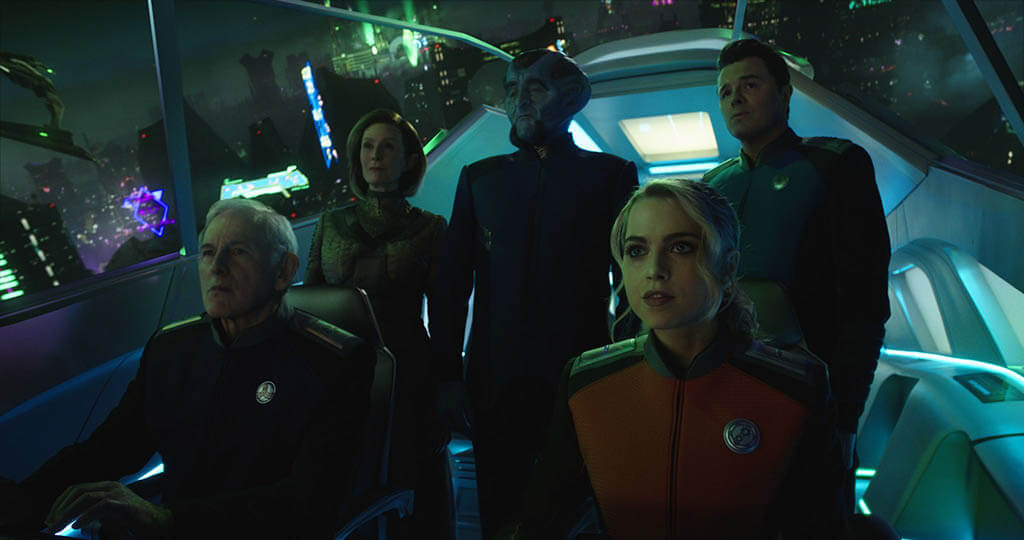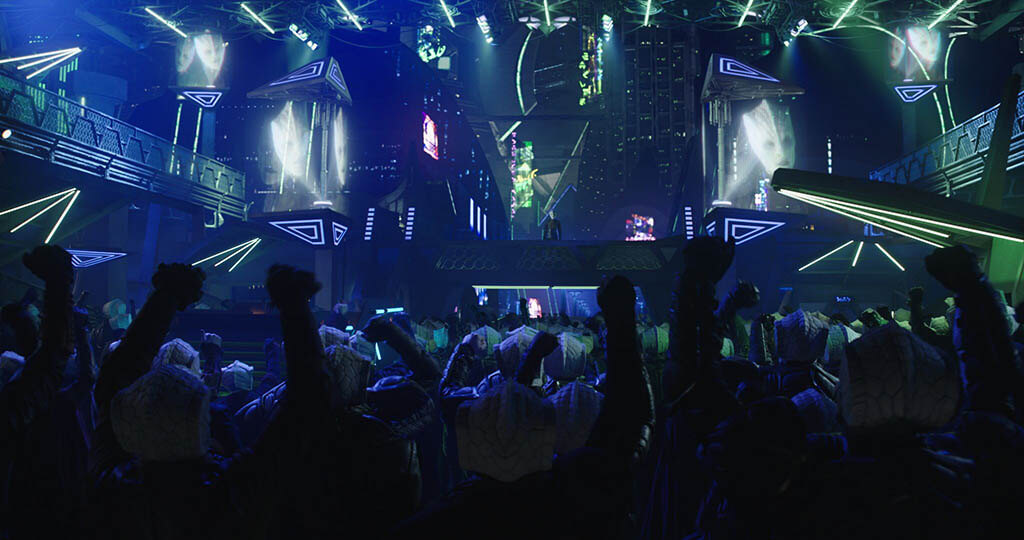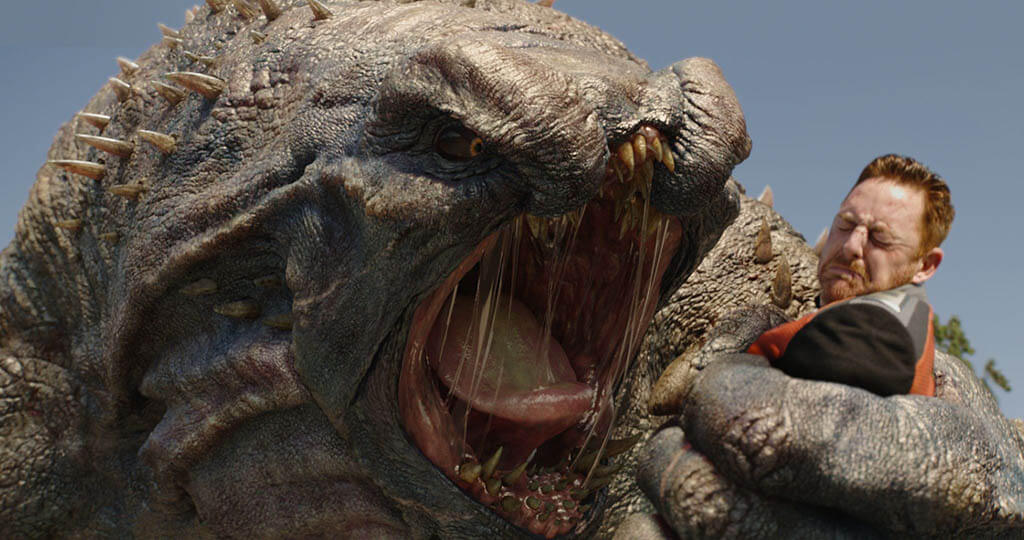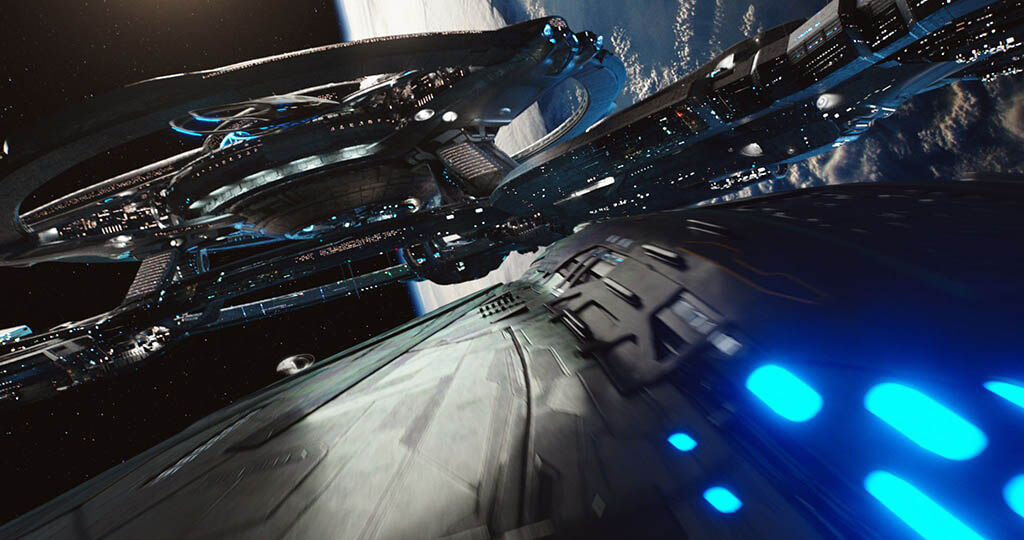Images courtesy of FuseFX and Hulu.
Commander Kelly Grayson (Adrianne Palicki) and Charly Burke (Anne Winters) in their flying suits for a crucial mission during the battle on Draconis 427.
For its third season, The Orville got a little more serious and a lot more expansive. In 2017, the sci-fi comedy series started out as something of a Star Trek homage/parody with a lot of broad humor. During Season 2 it evolved into a bolder sci-fi adventure with its own singular personality, and that transformation has continued into the third season, The Orville: New Horizons. There is still abundant humor aboard the USS Orville, but much of it now is more understated, and the show has long action sequences with no jokes at all. Along the way, the series tackles serious topics such as ostracism, gender identity and xenophobia, in a sci-fi setting. Accompanying the evolving narrative tone is a significant boost in the production values of the show, especially in its complex visual effects.


In The Orville Season 3, Captain Ed Mercer (Seth MacFarlane), Charly Burke (Anne Winters) and three Planetary Union officials fly to the Krill city.
“The entire season eclipsed all other seasons by far when it came to budgets, scope and complexity of shots. Every shot felt three times bigger than in past seasons,” says Tommy Tran, Visual Effects Supervisor for FuseFX, which was the leading VFX studio for Season 3 of The Orville. “Not only were the space battles grander, but also many new environments were introduced.”
“The entire season eclipsed all other seasons by far when it came to budgets, scope and complexity of shots. Every shot felt three times bigger than in past seasons, Not only were the space battles grander, but also many new environments were introduced.”
—Tommy Tran, Visual Effects Supervisor, FuseFX


Looking through the viewport at the Krill city. Its layout started as previs from Brandon Fayette, the production side VFX Supervisor.
The series ran on Fox for its first two seasons, then switched to Hulu for Season 3 (it now streams on both Hulu and Disney+). The show follows the adventures of a Planetary Union ship in the 25th century, with a cast that includes creator and co-writer Seth MacFarlane (Capt. Ed Mercer), Adrianne Palicki (Commander Kelly Grayson), Penny Jerald (Doctor Claire Finn), Peter Macon (Lt. Commander Bortus) and Scott Grimes (Lt. Gordon Malloy).


A political rally takes place in the Krill city marketplace, which combined a practical set with CGI buildings, bridges, billboards and aerial vehicles.
Besides FuseFX, more than a dozen VFX studios helped with 7,000+ VFX shots spread over 10 episodes. Ingenuity Studios, Crafty Apes, Barnstorm Studios, Pixomondo and Tippett Studio also contributed some key work. Tran comments, “Brooke Noska [production side VFX Producer/Co-VFX Supervisor] deserves all the credit for finding the multitude of other vendors to finish the season on time. I don’t know how she did it because, as some of us know, post-COVID, the flood of VFX work had pretty much saturated all facilities with projects around the globe. So, to get a new vendor on board, acclimate them to a three-seasons-old pipeline and give them very complex sequences was no easy task. To me, her new job title should be ‘miracle worker.’”
The Krill city on planet Krill. Patrick Horne, a CG Supervisor, populated it with innumerable buildings, city centers, roadways, aqueducts and holographic billboards.
FuseFX went from a smaller role in Season 1 to becoming one of the major vendors in Season 2. Tran and Nosca (as Visual Effects Producer) were part of the team nominated for the 2019 Emmy Award for Outstanding Special Visual Effects for the episode “Identity Part II.” For Season 3, FuseFX alone worked on 2,100 shots that covered multiple space battles, the new Pterodon Union fighter, a USS Orville upgrade and various alien planets.
“Imagine [the Orville] flying into Jupiter’s storm eye. It was a massive undertaking by our 3D and FX departments led by Christian Gonzalez and Tyler Britton, respectively. Tons of CG hurricane-like vortexes surrounded by FX smoke sims accompanied by lightning and interactive lights made the Jovian sequence one of the most beautiful sequences of the season, in my mind.”
—Tommy Tran, Visual Effects Supervisor, FuseFX

FuseFX utilized deep learning to de-age country music legend Dolly Parton for a scene where her hologram talks to her fan, Heveena (Rena Owen), and performs the song “Try.”
The new environments were the biggest challenges for FuseFX. This included creating the Jovian planet, the Krill planet and the Science Outpost in Episode 9, according to Tran. For these achievements, “I have to give credit to Samantha Hernandez, our VFX Producer, and J.V. [Joseph Vincent] Pike and David Rey, two of our VFX/DFX Supervisors, for bearing so much of the workload.” Tran notes, “There were not only the artistic challenges of creating new worlds, but also something that few outside our industry understand, which is the sheer amount of data to manage and get rendered within the time constraints. Our environments were so massive that getting any given frame to render would sometimes take days, in the beginning anyway. This was something very worrisome to us towards the end of the season as the shots became more numerous and complex. Towards the end, through optimizing and pipeline adjustments, we managed to get render times down to a point where we were able to deliver on time.”
The Moclan Research Outpost on Draconis 427 was a major visual effects challenge for the FuseFX team.
Tran adds, “We often overlook the importance of pipelines and infrastructure when talking about visual effects. It’s so often just about the creatives and visuals, but without the support of FuseFx’s technical and resourcing departments, I don’t know if Season 3 could have been accomplished [with] the degree of success that it had.”
Lt. Gordon Malloy (Scott Grimes) pilots a Pterodon fighter, which was created for Season 3.
For Episode 1, the Orville encounters a Jovian (Jupiter-like) planet, which is an intriguing example of VFX planet-building and a treat for astronomy and space buffs. The Orville dives into the turbulent upper atmosphere of a gas giant in order to escape a pursuing vessel. “This was a fun one for us,” Tran says. The concept was “imagine flying into Jupiter’s storm eye.”
“[Concept for the Krill planet depicted] a vast, dark and dreary metropolis harkening to Blade Runner 2049 city sequences. The city layout came to us as previs from Brandon Fayette, the production side VFX Supervisor. It was a blueprint for the scale magnitude of the city. Then it was up to Patrick Horne, one of our CG Supervisors, to populate it with hundreds if not thousands of buildings, city centers, roadways, aqueducts and holographic billboards, using Clarisse to manage to build it all.”
—Tommy Tran, Visual Effects Supervisor, FuseFX
“It was a massive undertaking by our 3D and FX departments led by Christian Gonzalez and Tyler Britton, respectively,” Tran explains. “Tons of CG hurricane-like vortexes surrounded by FX smoke sims accompanied by lightning and interactive lights made the Jovian sequence one of the most beautiful sequences of the season, in my mind.”




Exterior views into the deck of the fully-crewed USS Orville set, finally enhanced with CG and dramatic lighting.
The dazzling visuals of the Krill planet began with a concept depicting “a vast, dark and dreary metropolis harkening to Blade Runner 2049 city sequences,” Tran recalls. “The city layout came to us as previs from Brandon Fayette, the production side VFX Supervisor [and part of the crew nominated for the 2019 Emmy]. It was a blueprint for the scale magnitude of the city. Then it was up to Patrick Horne, one of our CG Supervisors, to populate it with hundreds if not thousands of buildings, city centers, roadways, aqueducts and holographic billboards, using Clarisse to manage to build it all.”
Continues Tran, “Along with creating the city exterior, we made an all-CG Market Place set seamlessly integrated into the practical set built on stage. We took inspiration from the architectural language of the single-story set and built it to be an expansive multi-story city center, encompassing towering CG buildings, sky bridges, dozens of animated holographic billboards and aerial vehicles.”


An advanced alien on planet Narran 1 conjures up near-death fears for the crew, including Lt. Gordon Malloy (Scott Grimes), while held by this beast.
The surface of Gendal 3, another new planetary environment in the series, is seen in the holographic simulator on the ship in Episode 10. Lysella, a native of Sargus 4, wants to smuggle some advanced Orville tech to her home world, and Grayson shows her the danger of giving advanced technology to a civilization that’s not culturally ready for it. They see a thriving Gendal 3 and then the same planet five years later, ruined and desolate, after the inhabitants had used Union tech to seek power over each other.”
“The Dolly [Parton] sequence was something new for the team. We were very accustomed to doing all things space-related, so when we got news of this, we had to take a step back to see what routes were available to us. One was to do the traditional full CG method, which would involve head scans, 3D match moving, modeling, rigging, look development and, trickiest of all, animation. This method would have been costly and time-consuming, and we didn’t have time on our side. So, in the end, we pitched to Seth a much faster, less expensive and somewhat unconventional method: deep learning. He agreed to a test and was over the moon when he saw the initial results. The rest is history.”
—Tommy Tran, Visual Effects Supervisor, FuseFX

The USS Orville had an entire makeover for Season 3, adding thousands of panel lines into its surface and textural detail to hold up to close-up shots.
The planet Draconis 427 and the Moclan Research Outpost featured a sequence that was by far the biggest and most challenging of the season, according to Tran. “Not only were all the environment build-outs gigantic, but we were running out of daylight to get the shots delivered,” he says. “We had to break up into separate teams to accomplish this within the given time frame. The sky and ground battle had to be developed in tandem, which took months of work just to get out of the development stage. By far, the base and the massive trench that ran through it took the most time and effort. Rendering such massive amounts of data made for some very long days and nights. We had to be certain that it had to be technically correct when anything hit the farm, knowing we had only so many chances to get all the shots sent to and back from the render farm. Even with all the optimizing of scripts, a massive internal farm and utilizing the Cloud, rendering it all [was] a close call.”
The USS Orville, ready to dock in Season 3. The series had bigger VFX budgets and complexity of shots compared to previous seasons.
Episode 8 (“Midnight Blue”) had a different type of VFX to deal with, that of de-aging Dolly Parton to present a 1990s version of the country music legend. Her hologram meets with the Moclan revolutionary author Heveena (Rena Owen), a huge fan of the singer. A convincingly younger Parton gives out some sage advice and performs the song “Try.” Tran comments, “The Dolly sequence was something new for the team. We were very accustomed to doing all things space-related, so when we got news of this, we had to take a step back to see what routes were available to us. One was to do the traditional full CG method, which would involve head scans, 3D match moving, modeling, rigging, look development and, trickiest of all, animation. This method would have been costly and time-consuming, and we didn’t have time on our side. So, in the end, we pitched to Seth a much faster, less expensive and somewhat unconventional method: deep learning. He agreed to a test and was over the moon when he saw the initial results. The rest is history.”
A fleet of Planetary Union ships, freshly designed for Season 3.
The ships also required a lot of intense care. “Pre-pandemic, we knew that the entire fleet would get a facelift for Season 3. I think that Seth wanted a whole new look and feel to the episodes and wanted the third season to be epic and memorable. We were concerned about how to do this development task alongside shot work. Tragically enough, the pandemic shutdown of production shooting enabled us to use this time to do the upgrades,” Tran says.
The VFX included a battle simulation with Kaylon vessels. Besides FuseFX, more than a dozen VFX studios helped with 7,000+ VFX shots spread over 10 episodes.
Continues Tran, “Since the pandemic happened early in the season, we did not have sequences to work on when production stopped shooting. So instead of working on VFX shots, we used the ‘downtime’ to retrofit the entire ship library since we did not need production footage for this. Our CG team led by John Rouse spent the good part of five months re-working the ship assets to bring them up to Season 3 expectations. The Orville and space station were the two more complex upgrades, which took the most time to do.”
The revamped USS Orville and space station were among the VFX highlights of Season 3.
The Orville’s exterior received an entire makeover. “We cut thousands of panel lines into its surface,” Tran explains. “We added textural detail to it to hold up to close-up ‘paint scraper’ shots. Its shader network was also revised to give its lighting a more cinematic feel than in past seasons. Also, we introduced an entirely new shuttle and Pterodon Fighter in this time frame.”
Planetary Union ships converge on debris of destroyed ships and a science station above planet Sabik 3.
Concludes Tran, “The highlight of Season 3 would have to have been the sense of accomplishment after all was said and done. I have to admit that it was not easy. The team and I spent the better part of three years on the project together, safe to say, the biggest of any of our careers. Not a week went by without a new challenge to overcome, whether it was creative, technical or time related. Although everyone on the team was wholeheartedly committed to the project, there comes a point in time when the soul is strong, but the flesh becomes weak. But at no time did we as a team surrender to the challenges. We kept pushing each other along and motivated each other when we sensed someone needed a breather. Together, we managed to deliver something to be proud of, something visually stunning and something seemingly unachievable by some. Only those involved will know how much effort, sacrifice and camaraderie was involved, which turned a group of colleagues into a family. I still have our daily meetings and reviews on my calendar as a reminder of my team, my family and the unforgettable journey we shared. I miss those days.”
